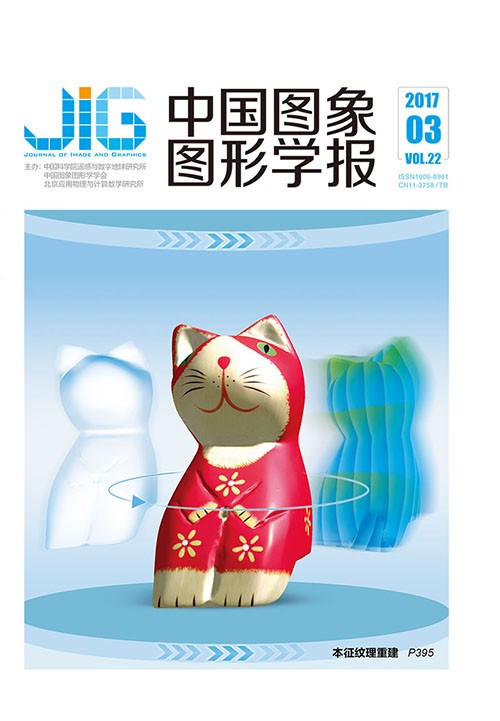
中心矩形构图先验的显著目标检测
摘 要
目的 许多显著目标检测算法侧重从背景角度进行显著性检测,而从前景角度和空间角度进行显著性检测的算法较少,为了解决这个问题,提出了一种基于中心矩形构图先验的显著目标检测算法。方法 假定目标分布在中心矩形构图线附近。首先,对图像进行超像素分割并构造闭环图;其次,提取中心矩形构图线上的超像素特征,并进行流形排序,获取初始显著值;然后,通过基于中心矩形构图线获取的初始显著值确定中心矩形构图交点显著值和紧凑性关系显著值;最后,融合三者获得最终的中心矩形构图先验显著图。结果 通过MSRA-1000,CSSD,ECSSD,THUS-10000数据集对比验证了中心矩形构图先验算法有较高的准确度和最高的F-measure值,整体效果上优于目前先进的几种算法。且处理单幅图像的平均时间为0.673 s,相比与其他算法也有较大优势。结论 从前景角度和空间角度考虑的中心矩形构图先验的显著目标检测算法相比于传统的算法更加具有鲁棒性,无论图像是复杂的还是简单的,都取得很好的检测效果,充分说明算法的有效性。
关键词
Saliency detection based on center rectangle composition prior
Song Tengfei, Liu Zhengyi(College of Computer Science and Technology, Anhui University, Hefei 230601, China) Abstract
Objective The saliency detection of RGB images has gained popularity in recent years. Saliency detection aims to quickly and accurately find salient objects in an image. Existing saliency detection methods utilize center prior, boundary prior, and color contrast methods. The center prior method is based on the assumption that salient objects are in the center of the image. The boundary prior method is based on the assumption that the image boundary is in the background instead of the foreground. The color contrast method is based on the principle that objects and their surroundings have varying contrast. Diffusion-based compactness method on the basis of the principle that salient objects typically have compact spatial distributions, whereas background regions have a wider distribution over the entire image. Fusion is required given that each method has its own advantages and weaknesses. In photography, important objects are placed at photographic composition intersections or arranged along photographic composition lines. Inspired by this photographic composition rule, we proposed saliency detection method based on the center rectangle composition prior, which assumes that the salient object is near the central rectangular composition lines. To supplement the weakness caused by assumptions- for example, the salient object is not near the center rectangular composition lines- we fuse compactness method to correct its result from spatial distribution. The compactness method calculates the spatial variance of each superpixel, as well as computes the spatial distance of the superpixels from the photographic composition intersection or the center of image. The choice of photographic composition intersection lies on cover range of the four intersections in initial saliency map.Methods First, the image was converted into superpixels and a graph model was described. Then, we set the superpixels in the central rectangle composition lines as query nodes, extracted their color feature to rank with all the other regions by manifold ranking, and then generated the center rectangle composition lines saliency map. Third, we computed the spatial variance of each superpixel to generate compactness relation distribution saliency map. Fourth, we found all the photographic composition as intersections, which are salient in a center rectangle composition lines saliency map. Finally, we calculated and combined the spatial distance of superpixels from them to generate photographic composition intersection saliency map. If no singular data are found, the center point of image was selected. Finally, the final saliency map was obtained by fusing the center rectangle composition lines saliency map, center rectangle composition intersection saliency map, and compactness relationship distribution saliency map.Results Experiments were performed to compare the performances of nine different methods using MSRA-1000, CSSD, ECSSD, and THUS-10000 databases. Results showed that our final saliency maps were closer to the ground truth and our method had better precision-recall curve and higher F-measure value. Our method had an average running time of 0.673 s for one image, thus achieving the real-time requirement. Moreover, experiments showed that although Monica can produce the original saliency results generated by other methods, all of them were greatly improved to a similar accuracy level after optimization by center rectangle composition prior calculation.Conclusion Our proposed method outperforms state-of-the-art methods given its effectiveness, robustness, and real-time application regardless of the complexity of the image or size of the salient object. These advantages are conferred by center rectangle composition prior and fusion of center rectangle composition lines prior, center rectangle composition intersection prior, and the compactness relationship.
Keywords
salient object detection center rectangle composition prior manifold ranking center rectangle composition lines center rectangle composition intersection compactness relationship distribution
|



 中国图象图形学报 │ 京ICP备05080539号-4 │ 本系统由
中国图象图形学报 │ 京ICP备05080539号-4 │ 本系统由